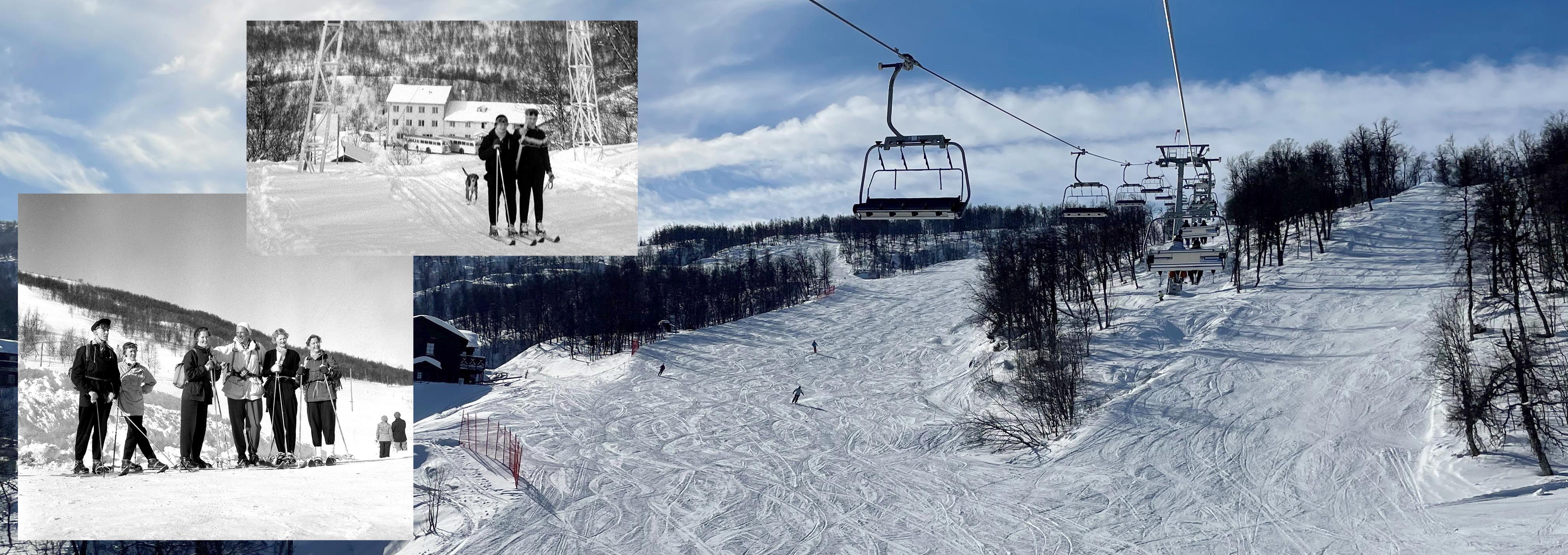It all began with a group of tourists requesting food and lodging. Learn about Ramundberget's exciting history, and see how many of today's activities have ties to the past.
Article published March 23rd, 2021.
The story of Ramundberget began in 1935, when some students who had celebrated Easter in Girtibaunastugan Cabin, six kilometers north-west of our valley, came across the mountain to knock on mountain-farming couple Agaton and Brita's front door. The students wanted something to eat, and a foundation was laid for today's mountain tourism. When the students returned the following year, Agaton and Brita offered them lodging, and the students started bringing friends and family.
Lifts and Piste Names
Most likely, Slalombacken existed long before a lift was built. It was traditionally an area of birch forest, which was chopped down for firewood. It was also used for hay-making. This organically made for an open space, which was perfect for skiing in the winter.
In 1958 the first lift - Slalomliften - was built to better serve Ramundberget's visitors. It is no longer there, but back in the day it ran right above the house that is Gästservice today. It was a combined ski tow and chair lift, with baskets hung up in summer in lieu of the wintertime T-bars.
Lagårdssvängen ("The Barn Run"), the slope that runs beneath Fjällgårdsbanan and slithers over to Topsport, is so named since the Topsport house is where the farming brothers' barn used to be.
The first part of Stjärnliften was built in 1972, and the other one six years later. Solliften was built in 1970, and the run Ängarna ("The Fields") carry this name as it's where hay used to be harvested on the mountain.
Inspiration from Skarsfjället
The skiing area in Western Ramundberget, served by Skarsliften, was built in 1980. The only thing that was there before was the downhill run Pelikanen ("The Pelican"), so called as it was frequented by visitors coming from Stockholm with mountain travel operator Pelikanresor ("Pelican Travels"). For a while, visitors were not referred to as tourists; they were referred to as "pelicans."
The runs in Western Ramundberget were named after areas on Skarsfjället, such as Dåeriesbaektie, 1,150 meters above the sea, and Kejsaren ("The Emperor"). So long as there's no fog or a snow storm, Skarsfjället can be seen clearly if you look west from Hotel Fjällgården. Fun fact: Skarsfjället is the mountain whose silhouette is seen in the Ramunderget logo!
Western Ramundberget is also home to Myhrsvängen, named after Christer ’Chrille’ Myhr. He tells us that Erling, one of Agaton and Brita's sons, asked him what they should call the run after they had finished chopping it up. "I said Myhrsvängen, and then that was it," he recalls.
Chrille has worked at Ramundberget since 1976, when he was 16 years old. His first job was to "prepare" the snow in Slalombacken by walking up and down on his own skis until the snow was flattened. For this, he was paid one bottle of soda. Today, he uses slightly more modern equipment - in fact, you've most likely seen him on the slopes in one of our piste machines!
Osthang and the Helags Massif
Most pistes in the Osthang area, which was built in 1990, were named after the Helags Massif, where the tallest Swedish mountain peak south of the Arctic circle stands at 1,797 meters. In Osthang, you can ski down Predikstolen ("The Pulpit"), Skaftet ("The Shaft") and Ekorrpasset ("Squirrel Run"); all names from the mountain.
However, Lillåssvängen was named after the nearby Lillåsvallen Shack.
A View to Geology
Before heading down one of our slopes, a tip is to look closely at the mountain opposite. In spring, when the snow melt has started, you can see shelves and stripes along the mountainside. They are tracks from the ice lake water of the inland ice, which scraped against the mountainside until it eroded. Nowadays, it is a pleasure to watch Ljusnan River snake through the valley in summer from a canoe.
Big thanks to Christer ”Chrille” Myhr for sharing your knowledge of bygone times.
